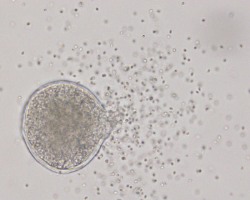In Japan, Manila clam stocks have drastically declined since the mid-1980's. The cause is still unclear and the stocks have not been restored in spite of various efforts. We hypothesized that Perkinsus species have caused the decline of Manila clam stocks in Japan, and are investigating the relationship between the depletion of wild Manila clams and Perkinsus species through laboratory experiments, field surveys and field experiments. In addition, we are trying to find ways to propagate and culture Manila clams without influence of Perkinsus infection. TOP
RESEARCH TOPICS
As of April 2023, these research topics are ongoing:
- Virulence of Perkinsus spp. in Manila clam (Itoh)
- Generation mechanism and chemotherapy of Cryptocaryon irritans (Watanabe)
- Control of Marteilioides chungmuensis infection in the ovary of Pacific oyster (Itoh)
Generation mechanism and chemotherapy of Cryptocaryon irritans (Watanabe)

Red sea bream infected with C. irritans.
We successfully cultured Cryptocaryon irriatns, which is the pathogen of marine white spot disease, in vitro feeding on cultured fish cells for the first time in the world. We are studying on pathogenic mechanisms and chemotherapy using Cryptocaryon irriatns cultured with this method. Now we are studying mainly on elucidation of environmental factors which causes the disease in culture farms and development of oral drugs. TOP
Control of Marteilioides chungmuensis infection in the ovary of Pacific oyster (Itoh)

Nodules in the ovary of a Pacific oyster
Ovary enlargement disease in the Pacific oyster Crassostrea gigas is caused by Marteilioides (=Marteilia) chungumensis. This protozoan parasite causes nodules in the gonad of infected oysters, leading to visible distension of their mantle surface and thus to marketability loss of infected oysters. This is a big problem in oyster farms in western Japan. Considering previous results of epidemiological surveys, seasonal changes of the disease and reproductive physiology of the Pacific oyster, we are studying on control measures to prevent damages to the oyster farming industry. Furthermore, in order to control the occurrence of the disease, we are trying to elucidate the life cycle of the parasite. We are currently seeking to construct a collaborative research system with many research institutions aiming to share information and knowledge. TOP
In addition, we had been studying on the following subjects:
- Internal defense system of shellfises and control of their diseases (Itoh)
- Infectious diseases of wild mantis shrimps (Yoshinaga)
- Drug therapy and host specificity of blood flukes in marine fishes (Yoshinaga)
- Risk communication for control of invasion of diseases from abroad (Yoshinaga)
- Ecology of Nymphonella tapetis in Manila clam (Yoshinaga)
- Allergen and ecology of nematodes of genus Anisakis (Yoshinaga)
Internal defense system of shellfises and control of their diseases (Itoh)
Production amount and target species of shllefish aquaculture is inreaseing globally, while a lot of shellfish diseases are appearing. However, unlike fishes, disease control by drugs is not practical in shellfish aquaculture because of the production in an extensive environment. We are studying on disease controling by activating innate internal defense system of shellfishes with various methods. TOP
Infectious diseases of wild mantis shrimps (Yoshinaga)
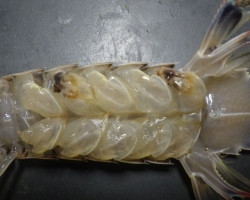
Individual with abnormal gills
In recent years, natural stocks of mantis shrimps have been drastically decreasing in many areas in Japan. Environmental changes are said to be the cause, but it is still doubtful whether they can completely explain the resource decline in several different areas. It has been reported that wild mantis shrimps were infected with Eumycetes and Oomycetes, but the influence of these pathogens on the resource decline has not been fully discussed. We are investigating the infection status in mantis shrimps in Tokyo Bay and Ise Bay, and attempting to identify the true pathogen. TOP
Drug therapy and host specificity of blood flukes in marine fishes (Yoshinaga)
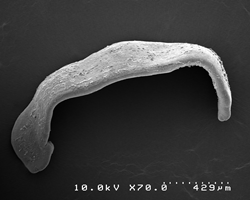
Electron microscopy of blood fluke.
Mortality from infection with blood flukes is a problem in farming of bluefin tuna and great amberjack. Praziquantel, an anthelmintic, is empirically known to be effective in controlling blood flukes. However, there is little fundamental information, e.g. effective concentration and action mechanism, which is necessary for developing drugs. We developed a method for culturing blood flukes infecting Takifugu poecilonotus, a species of puffer, in culture medium for a long time. We are using this method as an experimental model to aggregate information about the parasite. In addition, we are studying about the mechanism of the host specificity of blood flukes in the puffer. TOP
Risk communication for control of invasion of diseases from abroad (Yoshinaga)
A lot of pathogens have ever invaded from abroad into Japan and have damaged cultured and wild aquatic organisms. To solve the problem, it is necessary to share risk information and practice risk management with industry and parties concerned with farming and import of aquatic organisms as well as to develop legal systems. We are exploring how we should share risk information and build a consensus for risk management by hearing investigation, questionary investigation and action research and so on. TOP
Ecology of Nymphonella tapetis in Manila clam (Yoshinaga)
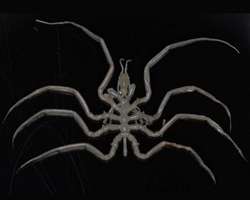
Adult Nymphonella tapetis.
Nymphonella tapetis, a species of Arthropoda, have caused mass mortalities of Manila clams in Tokyo Bay since 2007. We are studying the ecology of Nymphonella tapetis in collaboration with Chiba Prefectural Fisheries Research Center, and aim to find releasing and culturing methods to enable us to produce Manila clams regardless of the presence of this parasite. TOP
Allergen and ecology of nematodes of genus Anisakis (Yoshinaga)
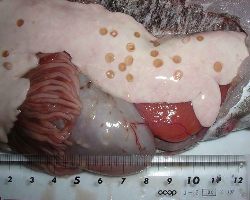
Anisakis on liver of Alaska pollock.
Anisakid nematodes are famous as a human-fish common pathogen and have recently been a problem on food sanitation as a cause of food allergy. In addition, it has recently become known that Anisakid nematodes infecting marine fishes in the sea near Japan include two species which have similar morphology. We are comparing allergens of the two Anisakis species, examining their biokinetics in fish by experimental infection and investigating their distribution in the sea near Japan. TOP
